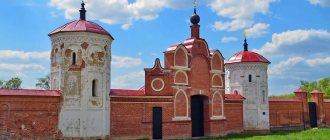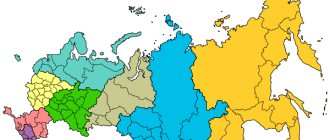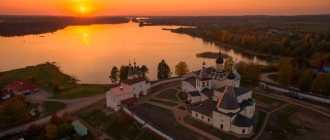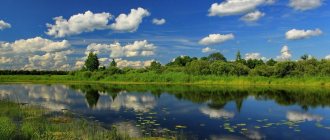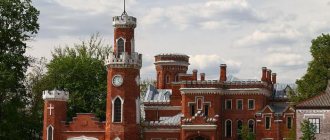More than 2/3 of the entire territory of the region is occupied by the Kola Peninsula, located beyond the Arctic Circle. The region includes several peninsulas and islands. On the satellite map of the Murmansk region, it is clear that it borders on:
- Karelia;
- Finland;
- Arkhangelsk region;
- Norway.
The administrative center is the city of Murmansk.
The hydrography of the region is represented by numerous large and small rivers and lakes. The largest freshwater body of water in area is Lake Imandra .
The most significant rivers of the Murmansk region:
- Umba;
- Cola;
- Tuloma;
- Crow;
- Niva;
- Varzuga;
- Ponoy.
The region's lands are occupied by tundra, northern taiga and mountain ranges, which are located in the western part. In the polar forests there are bears, wolverines, and wolves. The main riches of the Murmansk region are mineral resources , many of which are not found in other parts of the globe.
What holiday is it today?
February 10, 2022, Thursday
Today are holidays, events: Diplomat's Day Tomorrow: World Sick Day Discovery of insulin
Today is the Orthodox holiday: St. Ephraim the Syrian. Venerable Ephraim of Novotorzhsky. Venerable Ephraim of Pechersk, Bishop of Pereyaslavl. Venerable Theodosius of Totem, Spasosumorin of the monastery, leader and founder... Tomorrow: Transfer of the relics of the holy martyr Ignatius the God-Bearer. Saints Gerasim, Pitirim, Jonah, bishops of Great Perm, Ustva...
Today is a national holiday: Ephraim's Day... Tomorrow: Lawrence's Day
Seasons
Seasons, four periods of the year (spring, summer, autumn and winter) characterized by certain average temperatures. The period during which the Sun passes through one of these sectors is called the season. Spring in the Northern Hemisphere and autumn in the Southern Hemisphere begin when the Sun passes through the initial circle of declination and its right ascension is 0° (vernal equinox). Summer in the Northern Hemisphere and winter in the Southern Hemisphere occur when the sun's right ascension is 90° (summer solstice). Autumn in the Northern Hemisphere and spring in the Southern Hemisphere begin when the sun's right ascension is 180° (autumnal equinox). The beginning of winter in the Northern Hemisphere and summer in the Southern Hemisphere is considered to be the winter solstice, when the direct ascension of the Sun is 270°... Next: Seasons. Russian folk calendar. Monthly words...
Content
- 1 Large cities 250-500 thousand people 1.1 Murmansk
- 2.1 Apatity
- 3.1 Kovdor
- 4.1 Polar
Folk calendar about every day
Every day one season always replaces another and this determines a person’s way of life. In connection with this, a folk calendar was formed in which there were practically no nameless, unmarked days. Every day was special, had its own purpose. All this was determined by climate conditions and astrological phenomena.
A calendar is a system for counting periods of time. The first calendars arose a long time ago, in ancient times, because there was a need to measure time. The word calendar comes from the Latin words caleo - to proclaim and calendarium - debt book. This is due to the fact that in Ancient Rome the beginning of each month was especially proclaimed, and because it was customary to pay debts on the first day of the month. Different peoples counted time differently. Some calendars are based on the changing phases of the moon - lunar calendars; in others - the change of seasons - sunny; in others, the length of the year was coordinated with the change of seasons, and the counting of months was associated with the phases of the Moon. Such calendars are called lunisolar.
In Rus', the calendar was called a monthly calendar. Every day, the month book covered the entire year of peasant life, “describing” day by day, month after month, where each day had its own holidays or weekdays, customs and superstitions, traditions and rituals, natural signs and phenomena. The cyclical nature of the calendar is reminiscent of human life, where spring is youth, summer is heyday, autumn is the time of harvesting fruits (it’s good if there are some, otherwise you can live your life without collecting fruits), winter is the time of wisdom and peace. This cyclicality and rhythm determined the way of life of the farmer. The folk calendar was an agricultural calendar, which was reflected in the names of the months, folk signs, rituals and customs. Even the determination of the timing and duration of the seasons is associated with real climatic conditions. Hence the discrepancy between the names of the months in different areas... Next: Folk calendar...
see also
- Murmansk region
- Cities of Russia
| [ + ] Cities by regions of Russia | |
| Cities of the North-West (NWFD) | St. Petersburg (and its cities) • Leningrad region (historical Staraya Ladoga) • Arkhangelsk region • Vologda region • Kaliningrad region • Karelia • Komi • Murmansk region • Nenets Autonomous Okrug • Pskov region |
| Cities of the Volga region (Volga Federal District) | Bashkortostan • Volgograd region • Kalmykia • Kirov region • Mari El • Mordovia • Nizhny Novgorod region • Orenburg region • Penza region • Perm region • Samara region • Saratov region • Tatarstan • Udmurtia • Ulyanovsk region • Chuvashia |
| Cities of Southern Russia (SFD) | Sevastopol (including Inkerman) • Republic of Crimea • Adygea • Astrakhan region • Krasnodar region • Rostov region |
| Cities of the North Caucasus (NCFD) | Dagestan • Ingushetia • Kabardino-Balkaria • Karachay-Cherkessia • North Ossetia - Alania • Stavropol Territory • Chechen Republic |
| Cities of the Urals (Ural Federal District) | Kurgan region • Sverdlovsk region • Tyumen region • Khanty-Mansi Autonomous Okrug - Yugra • Chelyabinsk region • Yamalo-Nenets Autonomous Okrug |
| Cities of Siberia (Siberian Federal District) | Altai Republic • Altai Territory • Irkutsk Region • Kemerovo Region • Krasnoyarsk Region • Novgorod Region • Novosibirsk Region • Omsk Region • Tomsk Region • Tyva • Khakassia |
| Cities of the Far East (FEFD) | Amur Region • Buryatia • Jewish Autonomous Region • Trans-Baikal Territory • Kamchatka Territory • Magadan Region • Primorsky Territory • Sakha (Yakutia) • Sakhalin Region • Khabarovsk Territory • Chukotka Autonomous Region |
| see also | Cities of the DPR, LPR, Transnistria, South Ossetia • Regions of Russia • Cities of Russia |
Fishing calendar for every day
The fishing calendar should not be taken as an absolutely indisputable truth. Fish biting is greatly influenced by a whole range of natural factors, as well as the influence on the nature of man himself. You must not forget that the fish’s bite depends and is determined not only by the calendar dates and biological cycles of their life, reflected in the calendar, but also, no less, by the state of their habitat; the bite also depends on weather conditions: air and water temperatures, cloudiness, wind direction and strength, etc... Next: Fishing calendar...
Small towns within the closed city of Aleksandrovsk
Polar
Population 17,296 people (2016). City of Military Glory. It is part of the ZATO Aleksandrovsk. The Northern Fleet's base is located on its territory.
Snezhnogorsk
Population 12,650 people (2016). It is part of the ZATO Aleksandrovsk. It is a city attached to the city-forming enterprise Shiprepair.
Gadzhievo
Population 12,532 people (2016). It is part of the ZATO Aleksandrovsk. On its territory there is a naval base of the Northern Fleet.
Orthodox calendar about every day
Orthodox calendar: Orthodox, Church and Christian holidays.
The church year is an alternation of weekdays and holidays. On weekdays, a person is called to work “by the sweat of his brow to earn his bread.” Holidays are given in order to feel liberation, to rise above the bustle and routine of the world, to feel involved in the highest of worlds, “where there are no illnesses, sorrows and sighs, but endless life.” Since ancient times, holiday cycles have been associated with the seasons. The pagans associated them with the worship of the forces of nature, the cult of which in the Old Testament was replaced by gratitude to the Creator for the universe. And although the connection between holidays and the seasons has not completely lost its power, since God is present in everything, in the plant and animal world, in human works, it nevertheless faded into the background, giving way to a spiritual foundation built on the Sacred Scriptures. The history of Orthodox holidays dates back to the times of the Old Testament. Each of the Orthodox holidays is dedicated to the remembrance of the most important events in the life of Jesus Christ and the Mother of God, as well as the memory of saints... Next: Orthodox calendar...
Economy
The main industrial enterprises of the Murmansk region operate in the following industries: fishing, ship repair, non-ferrous metallurgy, ore mining and processing. The mining and industrial complex accounts for about 60% of total industrial production. Due to the harsh climate, agriculture is poorly developed and only in the field of animal husbandry (reindeer husbandry and dairy cattle breeding.
The region is rich in mineral resources, the main ones being apatite, nepheline and iron ores (the latter account for about 10 percent of total Russian production). Oil is produced on the shelf of the Barents Sea, and the Shtokman gas field, which is one of the largest in the world, was discovered here.
The only tidal power station in Russia operates in the Murmansk region; there are also a number of hydroelectric power stations, the largest of which are Nzhinetulomskaya, Knyazhegubskaya, Verkhnetulomskaya. The Kola Nuclear Power Plant is operating with a capacity of 1,760 MW.
The tourism industry is developed - many Russian and foreign tourists come to the Murmansk region. Russians are primarily interested in ski resorts (Khibiny, Kirovsk), foreigners are interested in environmental and ethnotourism.
Russian folk calendar for every day
The word “sign” comes from the word “notice”, i.e. observe. As a result of observing what happens around a person every day, he accumulates life experience. This knowledge was passed down from generation to generation, carefully preserved and people trusted it as a sacred book. Many signs have come to us from the depths of centuries without losing their knowledge. Each of us is free to choose: to dismiss all this as an absurd superstition or to take a closer look at the signs and take the centuries-old experience of generations more seriously. Most of us, when taking exams, ask them to scold them, boasting about some kind of good fortune or luck, spit so as not to jinx them or knock on wood, take a detour if a black cat crossed the road, are afraid of the number 13 and much more. And who among us does not have lucky things, numbers? Who has never resorted to the help of fate at least once in their life, who has not believed in secrets? It’s as if everything connected with signs is hidden somewhere deep in our subconscious. Often we remember them mechanically, unconsciously, or just as a joke. But, undoubtedly, the signs contain a lot of accurate knowledge and practical wisdom of our ancestors. They cover all the characteristic, often difficult to perceive, natural phenomena. Signs have preserved a lot of what was in old folk holidays and customs; they help predict the weather, grow crops... Next: Folk signs...
Flora and fauna
The Murmansk region is covered with forest-tundra and tundra, only in the southern part in some places the area is characterized as northern taiga. In the north, dwarf birch and spruce are the most common, with pine found in some places. The tundra is mainly covered with lichens and mosses, and there are many berries (blueberries, cranberries, blueberries, cloudberries). However, in general, the flora of the Murmansk region cannot be called diverse, which is typical for all northern regions of Russia.
The fauna is also not very diverse. In total, 32 species of mammals live here (there are 10 times more species in all of Russia). The most common species are foxes, arctic foxes, martens, reindeer, and moose. There are wolves, wolverines and brown bears. In the southern regions, lynxes, roe deer and wild boars often appear. Lots of lemmings and squirrels.
There are 280 species of birds in the Murmansk region, the most common are tits, gulls, terns, ptarmigan, black grouse, and bullfinches. In the forests you can find polar owls. The region is rich in fish (both sea and freshwater). In the seas they catch cod, halibut, flounder, herring, navaga, catfish and other species. The most common species in rivers and lakes are pike, burbot and perch, trout, whitefish, nelma, palia, and grayling.
Holiday calendar, dates and events of the year
All state and professional holidays in Russia, including significant World and International holidays, and other equally interesting holidays and events about every day.
The holiday has always kept pace with the history of mankind. Social time can be divided into three types: everyday life (weekdays), weekends and holidays. Everyday life is a series of practices repeated day after day and every day (work). Weekends are regular breaks from the rush of everyday life. It is believed that on weekends a person should restore his strength after working days. Day off, non-working day. A holiday is a day of celebration established in honor or in memory of someone or something. A day or series of days celebrated by the church in memory of a religious event or saint... Next: Calendar...
Medium-sized cities 20-100 thousand people
Apatity
Population 56,730 people (2016).
Severomorsk
Population 51,004 people (2016). The closed city is the main naval base of the Russian Northern Fleet.
Monchegorsk
Population 42,893 people (2016).
Alexandrovsk (Murmansk region)
There are other meanings of this name, see Alexandrovsk
Population (urban) 42,478 people (2016). A closed administrative-territorial entity with the status of an urban district, includes three small cities: Polyarny, Snezhnogorsk and Gadzhievo.
Kandalaksha
Population 32,592 people (2016).
Kirovsk
Population 26,971 people (2016).
Olenegorsk
Population 21,097 people (2016).
Prayer book, Orthodox prayers for every day
Prayer is the most powerful means for healing all illnesses - both physical and mental. Prayers can be laudatory or grateful, petitionary and repentant. If we have offended God, sinned, we must ask Him for forgiveness, that is, repent. Such prayers are called repentant prayers. If everything is fine with us, if we and our loved ones are healthy and prosperous, if we have a place to live, something to wear, something to eat, we must glorify and thank God for this. Such prayers are called praise or thanksgiving. If some misfortune, illness, trouble or need happens, you need to ask God for help. Such prayers are called petitionary... Next: Orthodox prayers...
For tourists
The Murmansk region is quite popular among tourists, who are primarily attracted by the nature of the Far North. Ethno-tourism and eco-tourism are gaining popularity; the ski resorts of Khibiny and Kirovsk are popular, where active recreation enthusiasts come from all over the North-Western Federal District.
Ski resort
There are many natural and man-made attractions in the Murmansk region. Here is a list of the most interesting and famous ones that are worth visiting:
- The K-21 submarine is located in Murmansk and is a museum;
- The Polar Botanical Garden-Institute in Kirovsk covers an area of almost 1,700 hectares. It contains a collection of unique plants that grow in indoor pavilions, greenhouses and outdoors;
- The Murmansk Oceanarium is an interesting place that is definitely worth a visit;
- Teriberka - this village has recently become very popular among tourists.
- This is only a small part of the attractions; there are many other interesting places, such as the Lovozero tundra, the Kola superdeep well, the Iron Gate gorge and others.
You can get to the Murmansk region by rail, plane or car. The most convenient type of transport depends on what type of holiday you prefer and what exactly you want to see. For example, some natural attractions and interesting places will be inaccessible to an ordinary passenger car. You can find out more detailed information on our website in the descriptions of attractions and interesting places.
If we talk about the tourism infrastructure, it is quite well developed, especially for ski resorts and large settlements.
Zodiac, astrological, eastern calendar. Zodiac signs
In ancient times, to establish the calendar, priests used knowledge of the positions of all the planets. Before the reform of Peter 1, the New Year was celebrated on the Day of the Autumn Equinox. On this day, according to ancient legend, the most peaceful treaty was concluded between the Great Race (ancient Slavs) and the Great Dragon (ancient Chinese) and it was approximately 7518 years ago... For the ancient Slavs, the calendar month corresponded to the lunar cycle from new moon to new moon, taking into account such Thus, the relationship of the entire annual cycle with astronomical and natural phenomena. There was no coherent calendar system. The main natural phenomena are still considered to this day to be the days of the solar equinox and solstice - the Slavic holidays Maslenitsa, Kupala, Ovsen and Kolyada. But during the time of Peter 1, all ancient Slavic calendars were abolished and a new Western European calendar from the Nativity of Christ (Julian calendar) was introduced, while the beginning of the calendar was moved to January 1. The Julian calendar (old style) did not take leap days into account and accumulated one extra day every 128 years. After the October Revolution in 1918, the Gregorian calendar (new style) was introduced in Russia, according to which an amendment of 13 days was introduced. The calendar of the ancient Slavs was based on two planets: the Sun and the Moon. And now they don’t use anything at all. The calendar has become static. There is no such thing as the calendar, it turns out, resting on some planet. Nobody even knows about it. There are just some standard numbers, there are months and holidays. The calendar is based on the Sun and Moon. Why is this so? Because these two luminaries influence the Earth. The Earth revolves around the Sun, and the Moon revolves around the Earth. And these two luminaries create the atmosphere on the planet. From here the calendar is built... Next: Astrological calendar...
Geography
The area of the Murmansk region is 144,902 square kilometers, the water surface accounts for 8.2% of the area. It has borders with Norway and Finland, and of the Russian regions on land it borders only with the Republic of Karelia. It is washed by the Barents and White Seas, through the latter it has a border with the Arkhangelsk region.
Most of the territory of the Murmansk region (70%) is located on the Kola Peninsula. Also, most of the region is located beyond the Arctic Circle. It is important to note that the Murmansk region is located on the Baltic crystalline shield, which explains the huge variety of minerals. In the depths of the region you can find 30% of the minerals known on our planet.
In the central part of the region there are mountain ranges, the highest of which are the Khibiny Mountains (the highest point is 1200 meters). Also worth noting are the Lovozero tundra (1120 meters), Monchetundra (965 meters) and others, lower. Thanks to these mountain ranges, active winter tourism is developed in the Murmansk region.
Despite the fact that neighboring Karelia is considered the “country of lakes”, in terms of this indicator the Murmansk region is not only not inferior, but also significantly superior. There are almost 110 thousand lakes with an area of more than 10 hectares, and 18 thousand rivers with a length of more than 100 meters. Such a large number of reservoirs is explained by the activity of the glacier, which, during its retreat, left scratches on the ground, which later became lakes and rivers.
The largest rivers of the Murmansk region are the Umba, Niva, Ponoy, Varzuga, Voronya, Tuloma, and Kola. The largest lakes are Imandra, Lovozero, Kovdozero, Kolvitskoye, Sergozero, Vyalozero. The deepest is Umbozero (maximum depth 115 meters). There are 20 large reservoirs.
Dream books online, interpretation of dreams
A dream book is nothing more than an interpreter of dreams and dreams, a translator of dreams. Since ancient times, people have been using dream books; dreams have always been given great importance, and people have often noticed the prophetic properties of some dreams. The dream book can become your faithful assistant every day and throughout your life, thanks to the dream interpreter you can always make the right decisions, the dream book will help you resist temptations in time, and will warn you against wrong steps and frivolous actions. Further…
Transport and roads
There are more than 2,500 public roads in the Murmansk region, of which about 96% are paved roads. Up to 73% of rural settlements have paved roads. In total, in the Murmansk region there are 17 kilometers of paved roads for every thousand square kilometers. The main transport route is P 21 “Kola”, which runs from St. Petersburg to the Norwegian border.
The total length of the railway tracks is 870 kilometers. However, the railway network as a whole is rather poorly developed; most of it is on the Oktyabrskaya Railway line, which connects Murmansk and St. Petersburg.
There are three airports: Khibiny, Murmansk, Lovozero. The latter operates domestic flights using Mi-8 helicopters.
